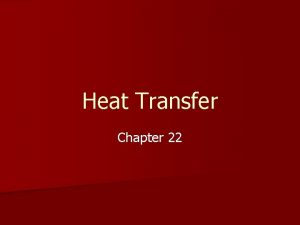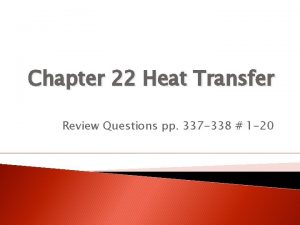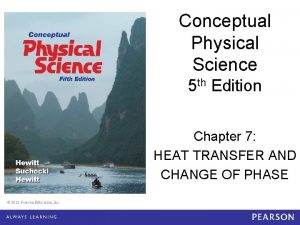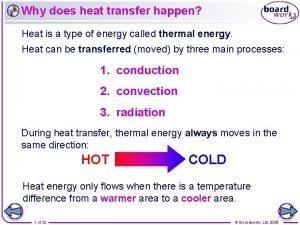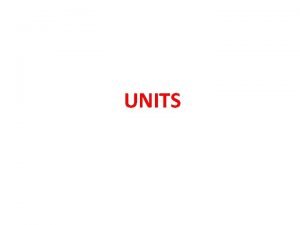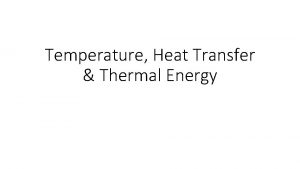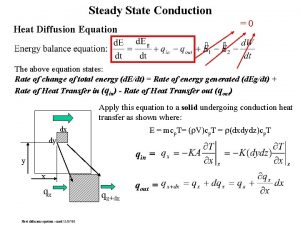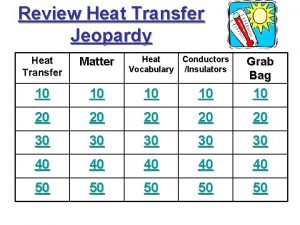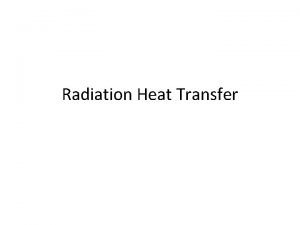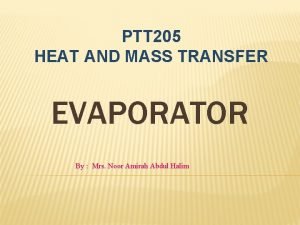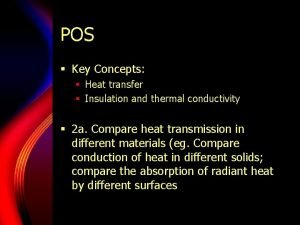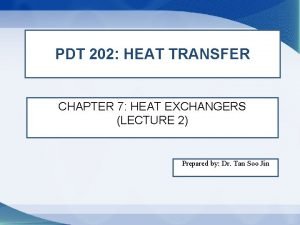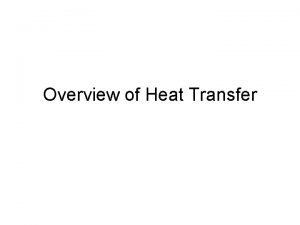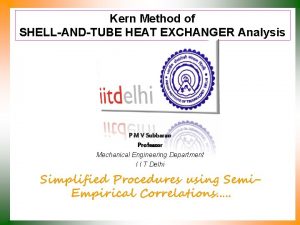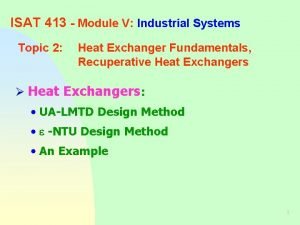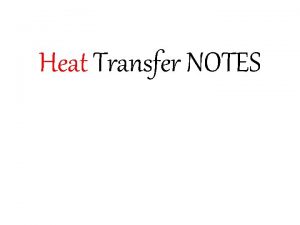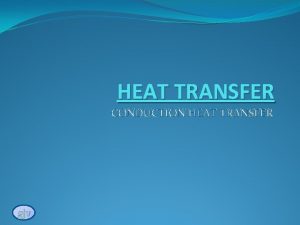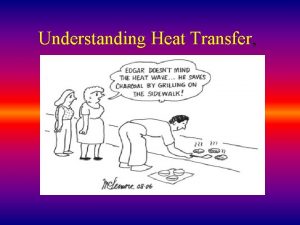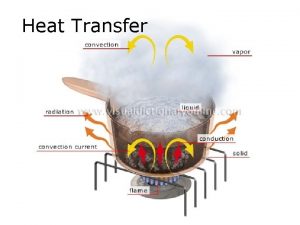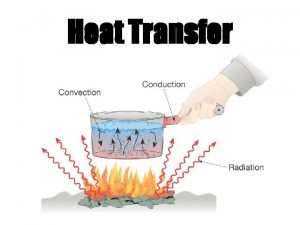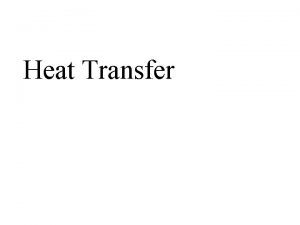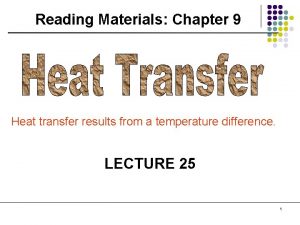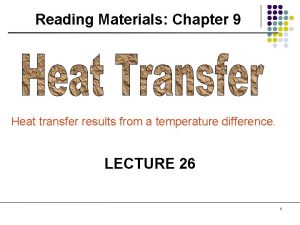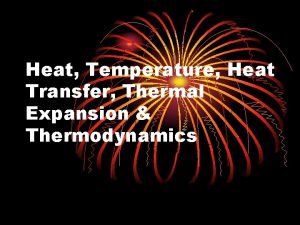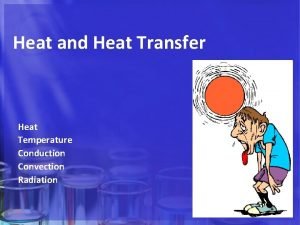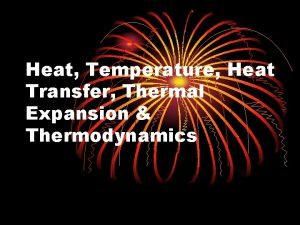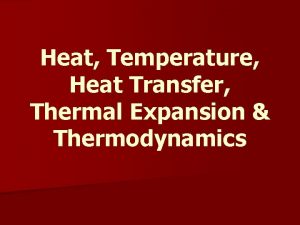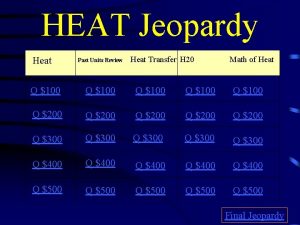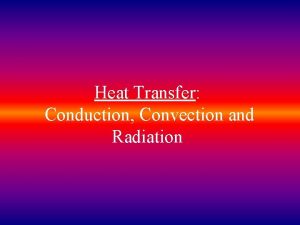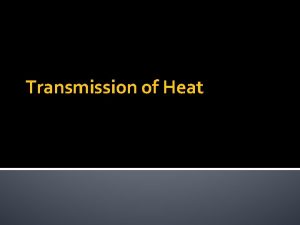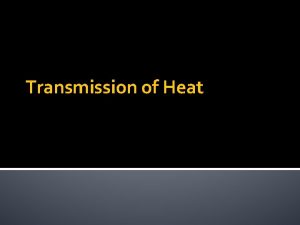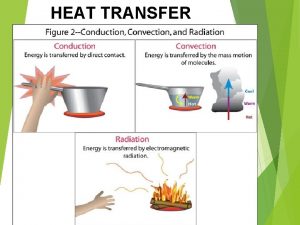Reading Materials Chapter 9 Heat transfer results from
























- Slides: 24

Reading Materials: Chapter 9 Heat transfer results from a temperature difference. LAST LECTURE 1

CONVECTION HEAT TRANSFER Modes q forced flow induced by external agency e. g. pump eg. forced-draught air cooler, evaporators q natural fluid motion caused by temperature-induced density gradients within fluid Examples air flow over hot steam pipe, fireplace circulation, cooling electronic devices 2

CONVECTION HEAT TRANSFER Figure: Natural convection flow over a heated steam pipe 3

Modelling Convection Forced convection generally most-effective transport of energy from solid to fluid. Engineer's prime concern rate of convection enables sizing of equipment 4

Modelling Convection Experimentally found that: h - convective heat transfer coefficient. Main problem predict h value for: • variety fluids & flow rates • range of shapes 5

Resistance Concept Rate equation Written in same form as Ohm’s Law: (Ts-Tb)= driving force (1/h. A) – thermal resistance (R) for convection heat transfer. 6

TYPICAL UNITS FOR h -2 -1 -1 -2 -1 S. I. : W m K or J s m K British: Btu hr ft (F deg) Conversion: 1 W m K = 0. 176 Btu hr ft (F deg) -1 -2 -2 -1 -1 -1 -2 -1 Typical Values free convection (air) 5 - 60 forced convection (air) 25 - 300 forced convection (water) 200 - 10, 000 boiling water 2, 000 - 25, 000 condensing steam 4, 000 - 110, 000 7

Illustration 27. 1 Air at 20°C is blown over an electrical resistor to keep it cool. The resistor is rated at 40, 000 ohm and has a potential difference of 200 volts applied across it. The expected mean heat transfer coefficient between the resistor surface and the air is 50 W m-2 K-1. What will be the surface temperature of the resistor, which has a surface area of 2 cm 2? 8

SOLUTION Energy Balance Generation = heat loss by convection Rate of heat generation Convective loss 9

Determining the size (H/T area) of the exchanger (10. 25) (10. 26) Figure 1. Heat transfer between two flowing fluids separated by a rectangular 10

Determining the size (H/T area) of the exchanger Figure 2: Heat transfer between two flowing fluids separated by a cylindrical wall (10. 27) 11

Overall heat-transfer coefficient As a short-hand method of describing heatexchanger performance, we use the overall heattransfer coefficient, (10. 28) 12

Determining the size (H/T area) of the exchanger 13

Illustration 27. 2 Consider the kettle below. For the conditions given, find the flame temperature for the following values of the heat transfer coefficients: hi (boiling) = 4000 W m-2 K-1 ho (gas flame) = 40 W m-2 K-1 14

Solution Plane slab- area constant, eliminate A: 15

Solution 16

Determining the size (H/T area) of the exchanger (10. 28 ) in equation 10. 28 represents the • The term Tavg temperature difference between the hot and cold streams averaged. • For single-pass exchangers, the appropriate form of Tavg is the log-mean temperature difference, Tlog mean (often abbreviated LMTD), defined as (10. 29 ) 17

Determining the size (H/T area) of the exchanger (10. 30) For shell-and-tube exchangers, the inside area (Ai) of the tubes is smaller than the outside area (Ao). However, the differences between Ai and Ao will be neglected. 18

Example Saturated Steam, 280 o. F, mstream Oil, 110 o. F, 960 lbm/min Hot Cold Saturated water, 280 o. F, mstream Oil, 35 o. F, 960 lbm/min Balance on cold stream: 19

Example How much area is required for the counter-current heat exchanger in Example 10. 5? 1 Saturated Steam, 280 o. F, mstream Oil, 110 o. F, 960 lbm/min 2 Hot Cold Saturated water, 280 o. F, mstream Oil, 35 o. F, 960 lbm/min 20

Example From table 10. 5 21

Example How much area is required for the co-current heat exchanger in Example 10. 5? 1 Saturated Steam, 280 o. F, mstream Oil, 35 o. F, 2 960 lbm/min Hot Cold Saturated water, 280 o. F, mstream Oil, 110 o. F, 960 lbm/min 22

Example From table 10. 5 23

Summary 24
 Pre reading while reading and post reading activities
Pre reading while reading and post reading activities Chapter 22 heat transfer exercises answers
Chapter 22 heat transfer exercises answers Dominoes are placed upright in a row
Dominoes are placed upright in a row Chapter 7 heat transfer and change of phase
Chapter 7 heat transfer and change of phase Wave is a disturbance that transfers energy
Wave is a disturbance that transfers energy Cant stop the feeling trolls go noodle
Cant stop the feeling trolls go noodle Material that can be useful and harmful
Material that can be useful and harmful Man made materials
Man made materials Adopting materials
Adopting materials Direct materials budget with multiple materials
Direct materials budget with multiple materials Heat transfer in metal
Heat transfer in metal Viscosity unit
Viscosity unit How does conduction transfer heat
How does conduction transfer heat Example of heat energy
Example of heat energy The heat diffusion equation
The heat diffusion equation Jeopardy
Jeopardy Four containers were filled with warm water
Four containers were filled with warm water Single effect evaporator calculations
Single effect evaporator calculations Thermal transmission
Thermal transmission Ntu heat transfer
Ntu heat transfer Heat transfer overview
Heat transfer overview Tube pitch ratio
Tube pitch ratio Ntu heat transfer
Ntu heat transfer We transfer
We transfer Examples of radiation heat transfer
Examples of radiation heat transfer

